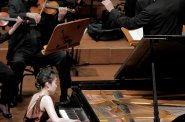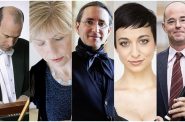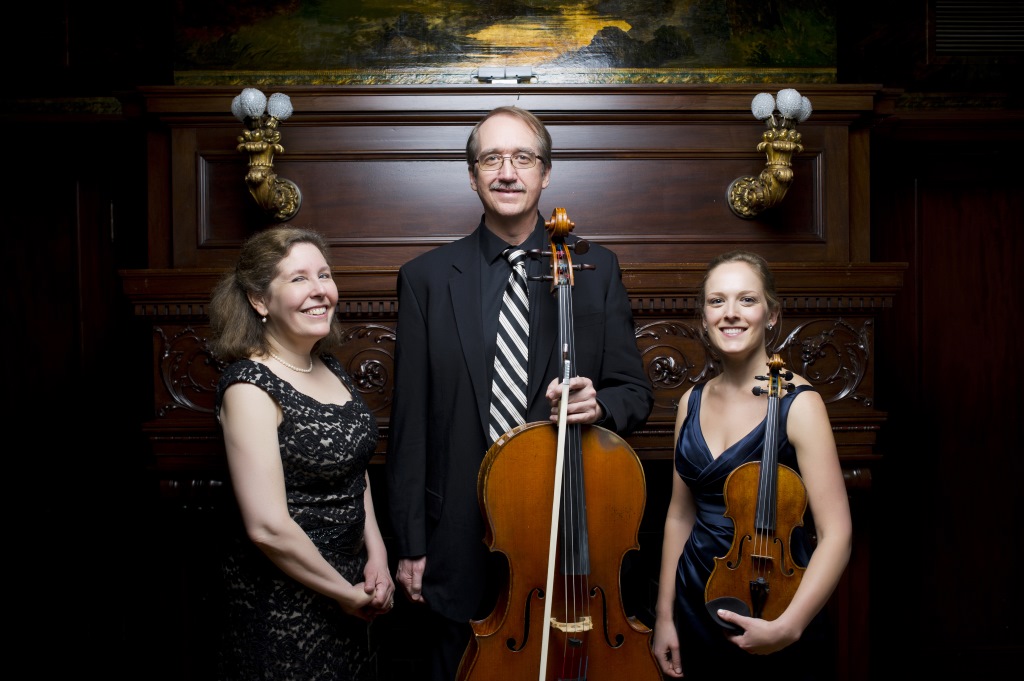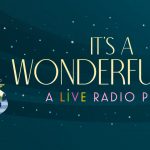Two Can Play As Well As Three
Prometheus Trio plays works for two by Schubert, Ravel and Martinů.
The Prometheus Trio completes its 19th season at the Wisconsin Conservatory of Music with concerts next Monday and Tuesday evening. The trio — violinist Margot Schwartz, cellist Scott Tisdel, and pianist Stefanie Jacob — have prepared a unique program which for the first time features duets.
Chamber orchestras offer the listener the chance to hear isolated instruments – a cleaner sound than from entire sections of instruments in a large orchestra. Quartets and trios permit the listener to focus more clearly on the interaction of the players. Intimate chamber music is about conversation. The process is even more apparent when only two instruments play together.
Consider a late work by Maurice Ravel, Sonate pour Violon et Violoncelle (1920-22), to be performed at this concert. The opening movement features a non-stop dialogue between violin and cello. Occasionally, the dialogue includes the cello crossing into the violin’s range. Critic David Yang notes that “Ravel uses tonality playfully, flipping between major and minor keys with ease, and experiments with the contrast between pizzicato (plucked) vs. bowed notes. The dream-like opening conjures up a vision of a lunar landscape. The cello enters as a strange but benign long-limbed creature dancing lightly in the low gravity. Soon a similar but smaller creature joins and the two engage in a weird private dance with leaping, whirling, spinning, shaking, and mock threatening moves against one another, all in play.”
The program’s centerpiece is a large work for violin and piano by Franz Schubert, Fantasie, D. 934 (1827), which challenges the players with virtuoso passages. Schubert bases the third movement on one of his most popular songs: a set of variations on a tune entitled, simply “Sei mir gegrüsst” (I greet you). The soulful melody reflects upon a love no longer present.
Says Richard Wigmore: “The first three variations are bravura showpieces, with shades of Paganini—then all the rage in Vienna—in the prancing, glittering violin figuration; the fourth recreates the song’s original lyricism, drifts towards C major and ushers in a shortened reprise of the introduction. This, in turn, leads to the Fantasy’s ‘finale’, a swaggering Allegro vivace in Schubert’s best Marche militaire vein.”
Jacob observes that Schubert’s melodies are enhanced by the way they are brought together. She admires the “juxtaposition of such wonderful harmonies,” especially in the transitions from a minor to a major key. This is, Jacob writes in program notes “An exhilarating and exhausting piece that we have both wanted to play for a long time—and are equally overjoyed and terrified that we finally are.”
Tisdel and Jacob will play a cello sonata by Bohuslav Martinů, Sonata No. 2 (1941). Tisdel has been champion of Martinů’s music, with good reason. A second movement elegaic largo fits the cello well. “Martinů understands the expressive potential of the instrument,” Tisdel observes, adding that “the sonority he creates” present the cello at its best and “a viola or violin wouldn’t have the same richness.” The work is balanced, however with players taking turns in dramatic interludes. Brian Reinhard observes: “There’s masterful drama in the dialogue and conflict between these instruments; it’s a troubled, brilliant piece that alternates between easy lyricism and abrupt outpourings, with a hint of triumph in the finale.”
The three players will close with a trio by Paul Schoenfield, Café Music (1986). The composer wrote: “my intention was to write a kind of high-class dinner-music music which could be played at a restaurant, but might also (just barely) find its way into a concert hall.” The work mixes Klezmer, ragtime and beautiful Eastern European melodies in a way that pleases audiences. But Jacob points out that the carefree expression lies within a formal sonata structure.
Patrons of the Prometheus should enjoy this opportunity to see the pairings of familiar players in performance. The program demonstrates that works for two instruments can be every bit as satisfying as works for three.
The Prometheus Trio will perform twice – at 7:30 p.m. Monday, February 22 and Tuesday, February 23 at the Wisconsin Conservatory of Music on 1584 N. Prospect Ave. General admission tickets may be purchased for $27.50 on the WCM website at 414-276-5760 or at the door. $37.50 will purchase padded front row seats, but the Conservatory ballroom offers an excellent acoustic anywhere in the room. Complimentary parking is available at Milwaukee Eye Care, 1684 N. Prospect Ave., located one block north of the Conservatory, for evening concerts.
Preview
-
PianoArts Festival Features Rising Stars
 May 28th, 2024 by Michael Barndt
May 28th, 2024 by Michael Barndt
-
Four Nations Ensemble Goes For Baroque
 May 13th, 2024 by Michael Barndt
May 13th, 2024 by Michael Barndt
-
Mozart on Prospect Avenue
 May 9th, 2024 by Martha Brown
May 9th, 2024 by Martha Brown



















